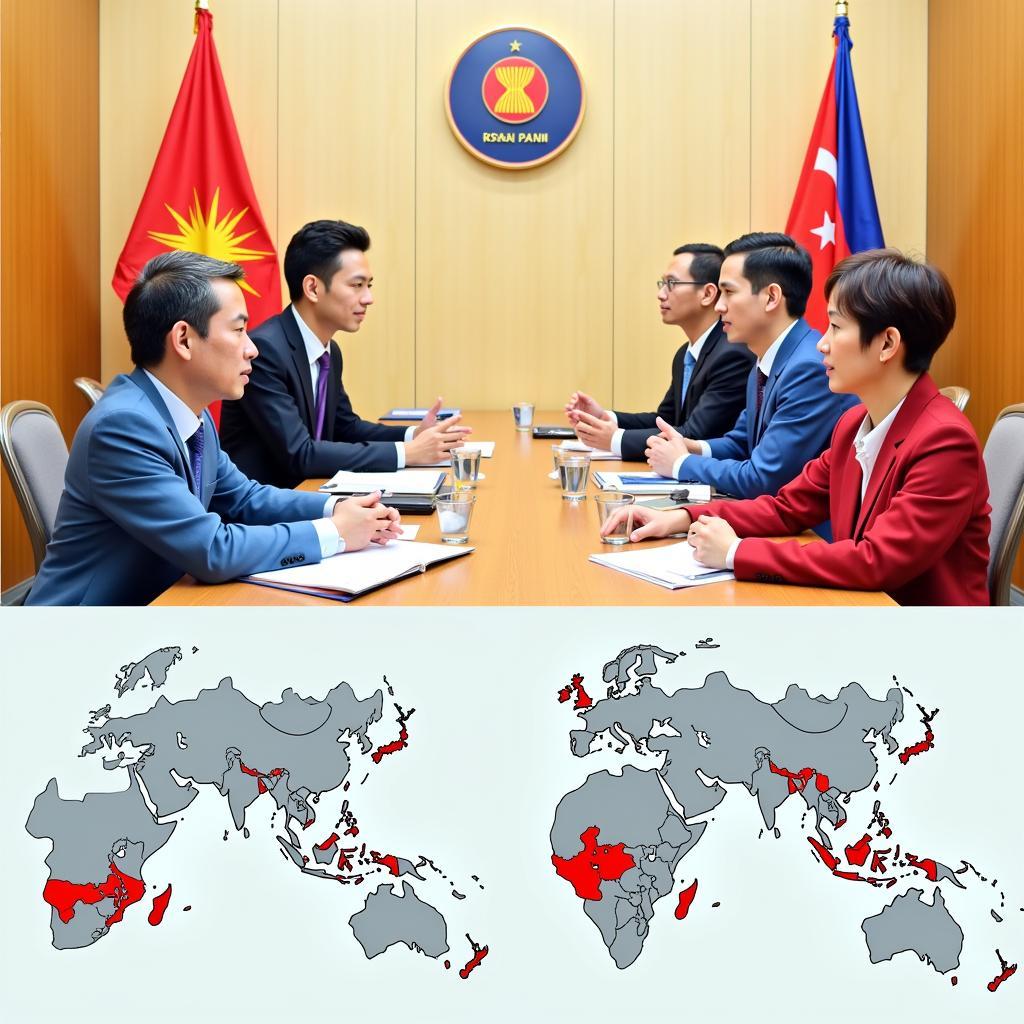The Association of Southeast Asian Nations (ASEAN) is a regional intergovernmental organization comprising ten countries in Southeast Asia. Established on August 8, 1967, ASEAN aims to accelerate economic growth, social progress, and cultural development in the region. It also seeks to promote regional peace and stability through adherence to the principles of the United Nations Charter.
Understanding ASEAN’s Core Objectives
At its heart, ASEAN strives to create a harmonious and prosperous Southeast Asia. The association pursues this vision through various means, always emphasizing dialogue, consensus, and cooperation among member states.
Promoting Economic Growth and Integration
One of ASEAN’s primary aims is to establish a thriving single market and production base. This involves:
- Enhancing trade facilitation: ASEAN actively works to reduce trade barriers, streamline customs procedures, and promote the free flow of goods and services within the region.
- Attracting foreign direct investment: A key purpose of ASEAN is to make Southeast Asia an attractive destination for foreign investors by improving the investment climate and providing a stable and predictable environment for businesses.
- Developing infrastructure: ASEAN recognizes the importance of robust infrastructure in supporting economic growth. The association facilitates cooperation among member states to develop cross-border infrastructure projects in areas such as transportation, energy, and telecommunications.
Advancing Social Progress and Development
ASEAN is committed to ensuring that the benefits of economic growth are shared equitably and contribute to improving the lives of people in the region. Key areas of focus include:
- Promoting human development: ASEAN aims to enhance the well-being of its people by investing in education, healthcare, and social protection programs.
- Narrowing the development gap: The association strives to reduce disparities among and within member states by promoting inclusive growth and addressing regional development imbalances.
- Empowering women and youth: ASEAN recognizes the crucial role that women and youth play in development and actively promotes their participation in all sectors of society.
Fostering Cultural Cooperation and Understanding
ASEAN celebrates the rich cultural diversity of Southeast Asia and acknowledges the vital role culture plays in fostering regional identity and unity. To achieve this, ASEAN focuses on:
- Preserving cultural heritage: ASEAN encourages the protection and promotion of the region’s diverse cultural heritage, including tangible and intangible cultural assets.
- Promoting cultural exchange: The association facilitates people-to-people exchanges through educational programs, cultural festivals, and artistic collaborations to deepen understanding and appreciation of different cultures within the region.
- Developing a shared ASEAN identity: While respecting national identities, ASEAN seeks to cultivate a sense of shared belonging and regional solidarity among the people of Southeast Asia.
Ensuring Regional Peace and Security
A cornerstone of ASEAN’s purpose is to maintain peace and stability in the region. This is achieved through:
- Peaceful dispute resolution: ASEAN provides a platform for member states to address and resolve disputes peacefully through dialogue, consultation, and negotiation.
- Preventive diplomacy: The association engages in preventive diplomacy efforts to address potential conflicts and maintain regional stability.
- Cooperation on non-traditional security challenges: ASEAN recognizes the transnational nature of many security threats and collaborates on issues such as terrorism, transnational crime, and cybersecurity.
 ASEAN Peacekeeping Efforts
ASEAN Peacekeeping Efforts
ASEAN’s Aims: A Vision for a Shared Future
The aims and purposes of ASEAN are interwoven, reflecting the interconnected nature of the challenges and opportunities facing Southeast Asia. By pursuing economic integration, social progress, cultural development, and regional security in tandem, ASEAN aims to create a more prosperous, peaceful, and harmonious region for present and future generations.
FAQ: Common Questions About ASEAN’s Goals
1. What is the main goal of ASEAN?
At its core, ASEAN aims to foster cooperation and integration among its member states to achieve economic growth, social progress, and regional stability.
2. How does ASEAN promote economic growth?
ASEAN promotes economic growth through trade facilitation, attracting foreign investment, and developing regional infrastructure projects.
3. What is ASEAN’s role in ensuring regional peace?
ASEAN provides a platform for dialogue and cooperation on security issues, promotes peaceful dispute resolution, and engages in preventive diplomacy to address potential conflicts.
4. How does ASEAN contribute to social development?
ASEAN works to improve the lives of people in the region by promoting human development, narrowing the development gap, and empowering vulnerable groups such as women and youth.
5. What is the significance of cultural cooperation for ASEAN?
ASEAN believes that cultural understanding and exchange are crucial for building a shared ASEAN identity and fostering greater unity and solidarity among its member states.
Need Assistance?
For any inquiries or assistance regarding ASEAN, please reach out to us:
Phone Number: 0369020373
Email: [email protected]
Address: Thon Ngoc Lien, Hiep Hoa, Bac Giang, Vietnam.
Our dedicated customer support team is available 24/7 to assist you.